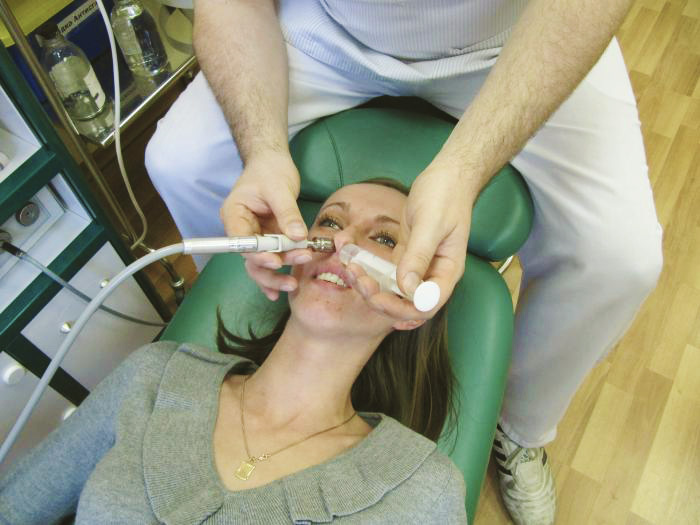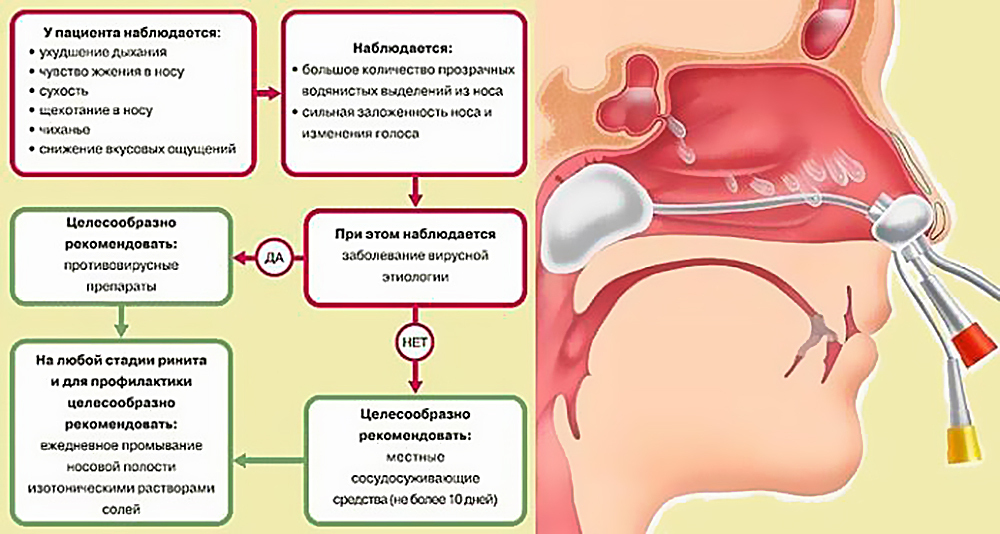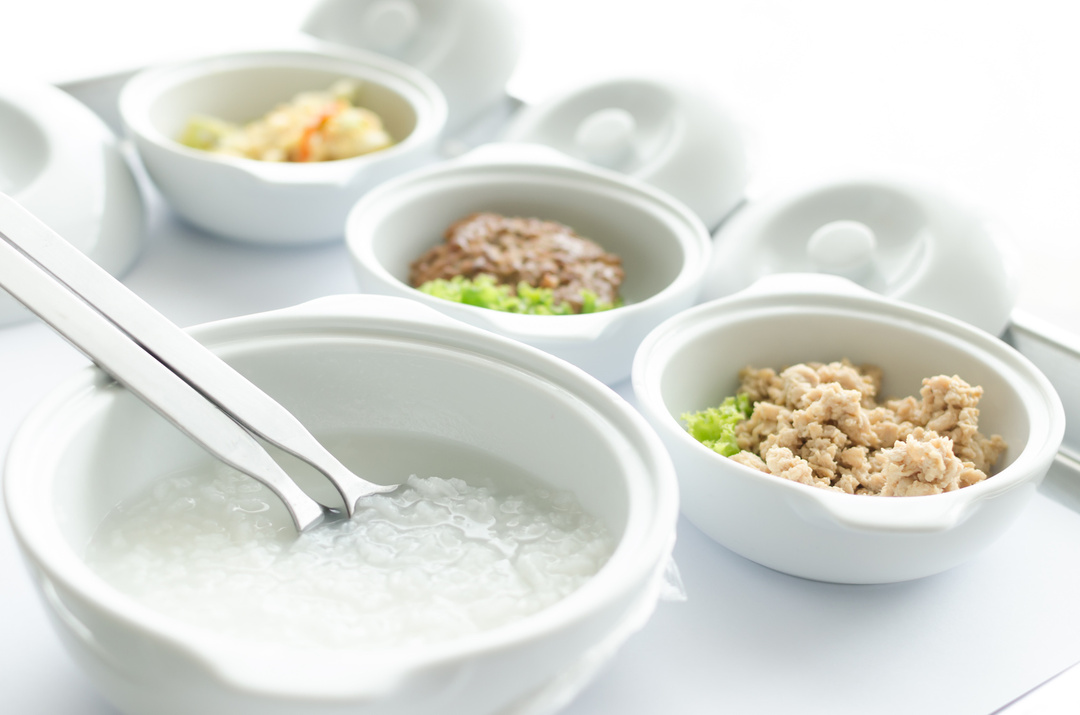Rhinitis: causes, symptoms, treatment, complications, prevention
 Rhinitis is an inflammation of the mucous membranes of the nasal passages.As a rule, it is accompanied by a runny nose, i.e. stuffiness of the nose, often - with the allocation of scanty or profuse secretions.Depending on the type and stage of development of rhinitis, the discharge can be watery or rather dense.
Rhinitis is an inflammation of the mucous membranes of the nasal passages.As a rule, it is accompanied by a runny nose, i.e. stuffiness of the nose, often - with the allocation of scanty or profuse secretions.Depending on the type and stage of development of rhinitis, the discharge can be watery or rather dense.
Inflammation of mucous membranes is caused by exposure to a bacterial or viral infection, hypothermia, allergens or hormonal changes( eg, rhinitis in pregnant women).As a rule, rhinitis is one of the signs of a common disease.
Table of contents: Classification of rhinitis Causes of nasal congestion Symptoms of rhinitis Complications of rhinitis Treatment of rhinitisClassification of rhinitis
According to the most common classification, rhinitis is divided into:
- infectious;
- is non-infectious.
Infectious rhinitis is characterized by either acute or chronic course. Chronic inflammations are subdivided into:
- catarrhal;
- hypertrophic;
- vasomotor;
- atrophic.
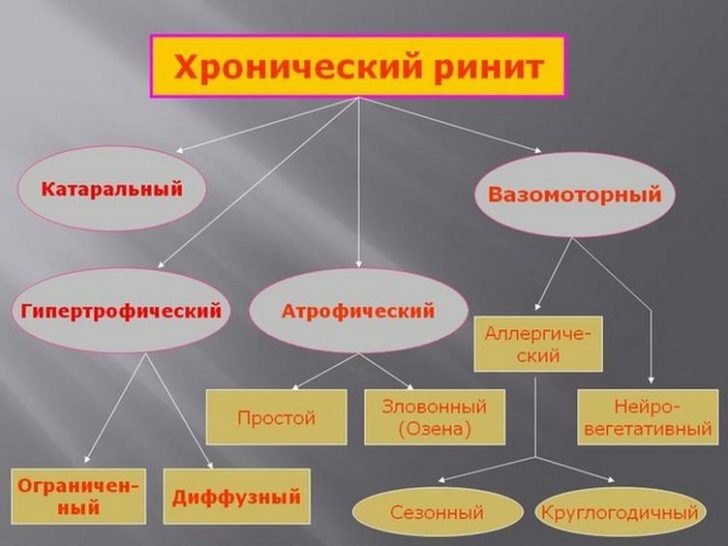 It is customary to consider such a form as ozena( malodorous atrophic rhinitis).
It is customary to consider such a form as ozena( malodorous atrophic rhinitis).
- allergic;
- Neurovegetative.
Reasons for the occurrence of nasal congestion
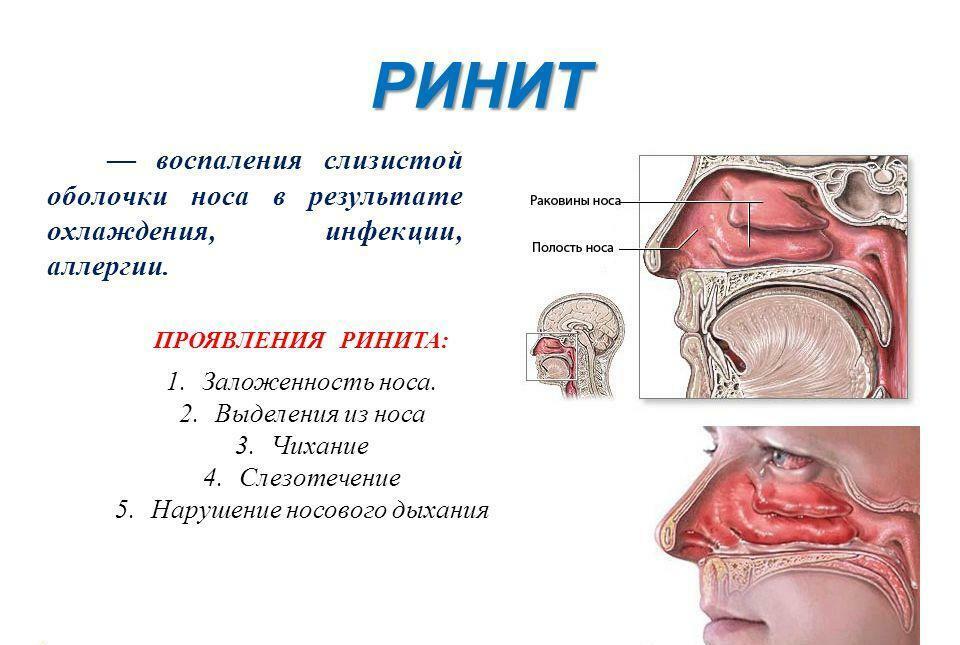 The most common etiologic factors are:
The most common etiologic factors are:
-
 bacteria( usually conditionally pathogenic microorganisms that are constantly present in the body and actively multiply against a background of decreased immunity);
bacteria( usually conditionally pathogenic microorganisms that are constantly present in the body and actively multiply against a background of decreased immunity); - viruses( adenoviruses, rhinoviruses, influenza and parainfluenza viruses, etc.);
- contaminated air( large amount of dust particles);
- chemical irritants;
- cold air;
- allergens.
The probability of developing acute bacterial rhinitis sharply increases with a general weakening of the body caused by such a stressor factor as total subcooling.Decreased immunity leads to rapid growth and reproduction in the nasal cavity of opportunistic microflora.
The introduction of bacterial or viral infectious agents develops a local response from the immune system.Its consequence is inflammation of the mucous membranes.In the area of inflammation, blood flow increases, which activates the secretory glands.As a result, a large amount of secretion begins, which can be watery-transparent( in the early stages of ARI) or viscous yellow-green( a few days after the onset of the disease).
 Allergens( eg pollen from plants) also cause inflammation, accompanied by swelling of the mucous membranes.Many noticed that nasal breathing is difficult after a long stay in the cold.The reason - in the alternate reflex narrowing and widening of the blood vessels, causing the development of edema.
Allergens( eg pollen from plants) also cause inflammation, accompanied by swelling of the mucous membranes.Many noticed that nasal breathing is difficult after a long stay in the cold.The reason - in the alternate reflex narrowing and widening of the blood vessels, causing the development of edema.
In turn, the swelling of the mucous membranes not only hinders the intake of air, but also reduces the activity of the glands secreting secret to moisturize it.As a result, the nose develops dryness and irritation, which are manifested by symptoms such as a feeling of itching in the nose and sneezing.
The development of chronic catarrhal rhinitis results in a decrease in overall immunity( as a result - frequent colds) and( or) a constant inhalation of contaminated air.This form may accompany some other chronic pathologies of ENT organs( including inflammation of the tonsils or paranasal sinuses).
 The peculiarity of the hypertrophic form of chronic rhinitis is the pathological proliferation of connective tissue, which makes it difficult or makes nasal breathing impossible.The process is localized, as a rule, in the posterior and inferior parts of the nasal concha.The cause of the development of pathology can be inflammation of the paranasal sinuses and palatine tonsils, adenoids and regular inhalation of aggressive chemical compounds.Among the predisposing factors - chronic alcoholism and hypertension.
The peculiarity of the hypertrophic form of chronic rhinitis is the pathological proliferation of connective tissue, which makes it difficult or makes nasal breathing impossible.The process is localized, as a rule, in the posterior and inferior parts of the nasal concha.The cause of the development of pathology can be inflammation of the paranasal sinuses and palatine tonsils, adenoids and regular inhalation of aggressive chemical compounds.Among the predisposing factors - chronic alcoholism and hypertension.
Some experts claim that there is a family predisposition to the disease. Specific factors leading to the development of atrophic form of rhinitis have not been identified at this time.It is assumed that the cause may be a change of climate, frequent colds with acute inflammation of the nasal mucosa, as well as some occupational hazards.It is also believed that atrophy promotes smoking.
The reasons for the development of the lake are not completely clear.According to the infectious theory, the leading etiologic factor is the Klebsiella microorganism.There is evidence of a family predisposition to the development of fetid atrophic rhinitis.Vasomotor rhinitis can accompany pathological conditions and diseases, which are characterized by a violation of the tone of the walls of blood vessels.This form is observed with reduced arterial pressure, neurocirculatory dystonia, asthenovegetative syndrome and some disorders on the part of the endocrine system.
Symptoms of rhinitis
Typical clinical signs of most rhinitis are:
-
 mucosal edema;
mucosal edema; - nasal congestion( difficulty in nasal breathing);
- isolates a significant amount of secretion;
- feeling of itching, burning or tickling in the nasal cavity;
- the voice of the voices;
- is an olfactory impairment.
Acute rhinitis in the initial phase is often accompanied by lacrimation, headache and symptoms of general malaise.Often the patient has a fever.At the first stage of the disease( its duration - from a few hours to 1-2 days) is practically non-existent, on the second - there are abundant discharge of watery consistency, and on the third - mucous or mucopurulent viscous secretion leaves.
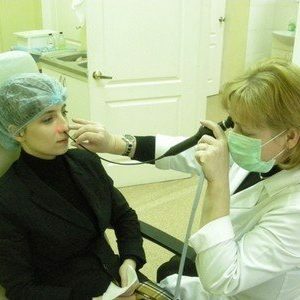 As a rule, the symptoms of rhinitis are observed for 1-1,5 weeks, after which recovery occurs.Chronization of the process and the development of a number of serious complications are also possible.
As a rule, the symptoms of rhinitis are observed for 1-1,5 weeks, after which recovery occurs.Chronization of the process and the development of a number of serious complications are also possible.
An indication of chronic catarrhal rhinitis is hyperemia of the nasal mucosa, which is revealed during instrumental research( rhinoscopy).
The hypertrophic form is characterized by the symptoms of severe nasal congestion leading to headaches, as well as a sharp decrease in smell and even a decrease in hearing acuity.In the course of the instrumental study, hypertrophy of the shells and apparent narrowing of the nasal passages are revealed.
Atrophic rhinitis is characterized by dry mucous membranes and regular crust formation in the nasal passages.The patient may experience occasional symptoms of nasal bleeding from time to time.If atrophic processes affect the olfactory zones, then the patient practically ceases to distinguish smells.At a rhinoscope the pallor of mucous is revealed.
Complications of rhinitis
The inflammatory process in some cases extends to other parts of the respiratory system and the middle ear, resulting in the development of sinusitis( inflammation of the paranasal sinuses), laryngitis, otitis, tracheitis and bronchitis.
With reduced immunity, even pneumonia( pneumonia) is not ruled out.The acute form of infectious rhinitis with inadequate therapy( or lack thereof) can become chronic.The consequence of carelessness is a constant violation of respiratory function, leading to pathological changes in the heart and lungs.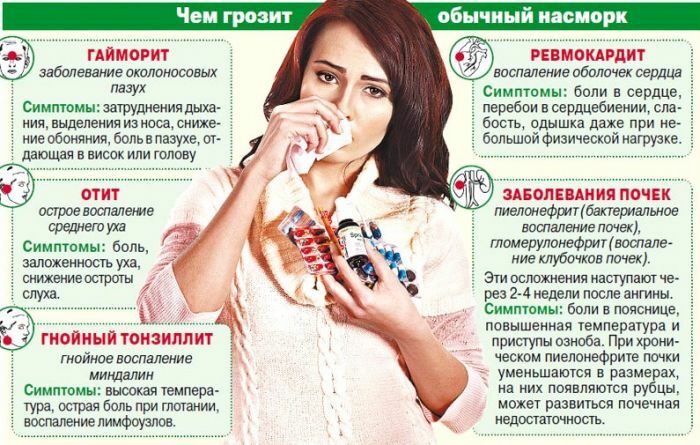
Treatment of rhinitis
Many believe that with a runny nose, treatment is not necessary, because "it will pass by itself."This is fundamentally wrong;Therapeutic measures allow to accelerate recovery and prevent complications.
Treatment of acute infectious rhinitis
Complex treatment of the common cold suggests:
- application of restorative agents( immunostimulants);
- thermal procedures( hot foot baths);
- physiotherapy procedures( eg - exposure to the soles of the soles by an ultraviolet lamp);
- distracting procedures( put mustard on the calf area).
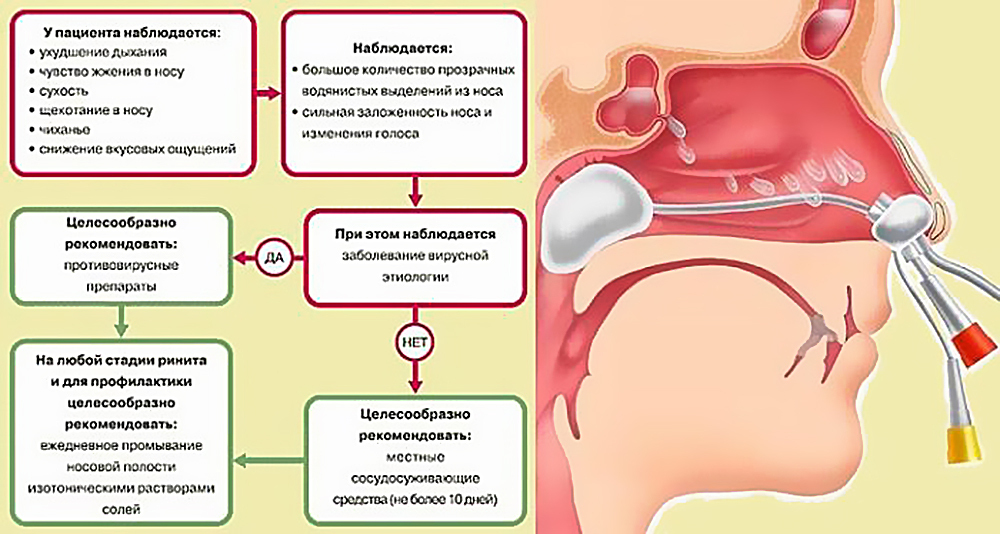
For the relief of nasal breathing, the use of local vasoconstrictive drugs based on xylometazoline, naphazoline or ephedrine is indicated.To soften the mucous membranes can be lubricated with their vegetable oil.Very effective drug is "Pinosol";A combined remedy reduces nasal congestion and provides softening of the mucosa.
Pay attention : for a long( more than 7 days) and frequent instillation of coagulating agents( Naphthyzine, Galazoline, etc.) leads to addiction and persistent changes in mucous membranes.A large number of patients abusing these drugs, formed a kind of drug dependence, and it is already a medical rhinitis.
In some cases, in acute bacterial rhinitis, rational antibiotic therapy may be indicated.Antibacterial drugs can be taken only as prescribed by the doctor and strictly in the recommended dosages.If the inflammation of the mucous membranes is viral, then antibiotics are absolutely useless.
Treatment of chronic rhinitis
 Effective treatment of catarrhal rhinitis should eliminate or minimize the effect of adverse factors.Most patients need to take measures to strengthen the body's defenses, which involves taking multivitamin complexes, as well as immunomodulators and immunostimulants. For topical treatment, ointments containing antibacterial substances, solutions with astringent effect, irrigation and washing with mucous antiseptics are recommended. Physiotherapy - UHF, quartz lamp irradiation and electrophoresis are also effective.
Effective treatment of catarrhal rhinitis should eliminate or minimize the effect of adverse factors.Most patients need to take measures to strengthen the body's defenses, which involves taking multivitamin complexes, as well as immunomodulators and immunostimulants. For topical treatment, ointments containing antibacterial substances, solutions with astringent effect, irrigation and washing with mucous antiseptics are recommended. Physiotherapy - UHF, quartz lamp irradiation and electrophoresis are also effective.
If complex conservative therapy of rhinitis does not give the expected result, then radical treatment is indicated - cryodestruction( low temperature effect) or moxibustion.Conservative measures in hypertrophic rhinitis are ineffective.The proliferation of connective tissue is an indication for surgical interventions.
In the initial stages, cryo-exposure, mucous vasotomy, chemical moxibustion, galvanoacoustics may be involved.Significant hypertrophy requires a conchotomy operation involving partial or total resection of the inferior shell.
With atrophic form, conservative therapy has proven itself.For topical application ointments with antibacterial and softening properties are shown.In the nasal passages, it is recommended to instill aloe vera juice and rose hip oil.The effective complex preparation is Aevit.The patient needs to take in the biogenic stimulants( extracts of medicinal plants and multivitamin complexes).
In the lake conservative treatment of rhinitis is carried out.The nasal cavity is washed with antiseptics( weak solutions of H 2 O 2 or manganese) and dioxin.After cleansing the nasal passages from the crusts, they inject the ointment with tampons.Patients also show systemic antibiotics.The vasomotor form of rhinitis involves the use of sclerosing drugs, as well as hormonal drugs from the group of glucocorticosteroids.A good effect is achieved by intra-nasal blockade.
In some cases, the application of surgical treatment may be indicated.Such methods as ultrasonic disintegration, laser destruction, submucosal vasotomy and galvanoacoustics are used.Allergic rhinitis requires the use of desensitizing agents and limiting contact with the suspected allergen.How to treat rhinitis correctly is described in this video:
Important: Prevention of rhinitis involves general strengthening of immunity, treatment of chronic ENT diseases and minimizing the impact of other etiological factors( physical and chemical).
Some features of the common cold in the child
Recommended to read: 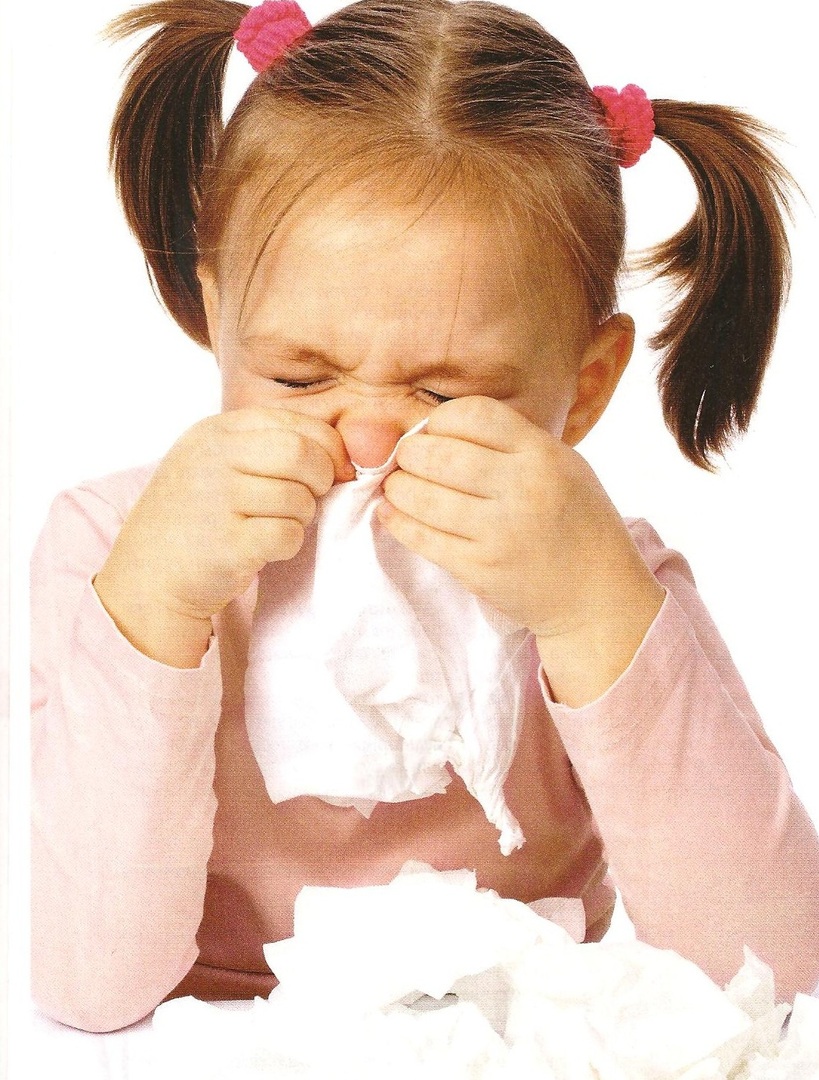 The causes of rhinitis in children are predominantly the same as in older patients.Rhinitis can also accompany "childhood infections", such as diphtheria, measles and rubella.In some cases, rhinitis is one of the clinical manifestations of some intestinal viral diseases.The possibility of developing rhinitis against the background of tuberculosis and specific infections received from the mother during passage through the birth canal( venereal diseases - gonorrhea and lyues) is described.
The causes of rhinitis in children are predominantly the same as in older patients.Rhinitis can also accompany "childhood infections", such as diphtheria, measles and rubella.In some cases, rhinitis is one of the clinical manifestations of some intestinal viral diseases.The possibility of developing rhinitis against the background of tuberculosis and specific infections received from the mother during passage through the birth canal( venereal diseases - gonorrhea and lyues) is described.
Rhinitis( rhinitis) in the infant never develops as an isolated disease.Since the baby is so far deprived of the opportunity to blow his nose, the detachable flows down the back wall of the pharynx.The spread of infection inevitably leads to rhinopharyngitis.Rhinitis in children is especially often accompanied by a fever, which is explained by imperfection of the immune system of the child.
Treatment of a runny nose in a child involves the use of physiotherapy procedures( electro- and phonophoresis, inhalation, reflexology).For successful therapy, regular airing of rooms and, if possible, the use of air ionizer filters are also necessary.Medicinal preparations( in particular - decongestants) are used mainly locally in the form of applications.Otrivin is a very effective drug for the treatment of rhinitis in children.
Rhinitis in pregnant women
 Rhinitis of pregnant women can be caused by an infection or hormonal in nature.During the period of gestation, the hormonal background changes dramatically, which affects the degree of vascular permeability.If there is toxicosis( gestosis), it leads to a change in the composition of the blood and the development of local edema( including mucous membranes of the nose).Treatment of a runny nose during pregnancy is effective if it is one of the clinical manifestations of ARI, i.e., accompanied by malaise and fever.
Rhinitis of pregnant women can be caused by an infection or hormonal in nature.During the period of gestation, the hormonal background changes dramatically, which affects the degree of vascular permeability.If there is toxicosis( gestosis), it leads to a change in the composition of the blood and the development of local edema( including mucous membranes of the nose).Treatment of a runny nose during pregnancy is effective if it is one of the clinical manifestations of ARI, i.e., accompanied by malaise and fever.
With hormonal rhinitis, therapy is symptomatic;Manifestations of this pathology independently disappear, as a rule, 1-1.5 weeks after childbirth.To facilitate nasal breathing during rhinitis in pregnant women, it is recommended to wash the nose with sea salt solutions and sleep with a slightly raised headboard.
More detailed information on the treatment of rhinitis at home is presented in the video review:
Local vasoconstrictor drugs for future mothers are contraindicated, since they negatively affect the functions of the placenta.It is acceptable to use a glucocorticosteroid agent, whose active ingredient is fluticasone propionate.
Konev Alexander Sergeevich, the therapist

